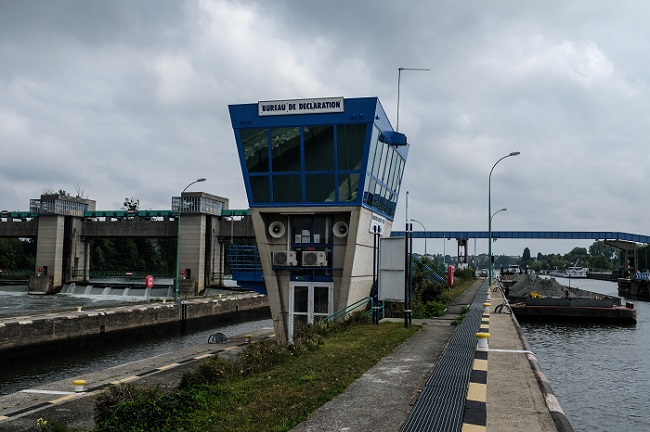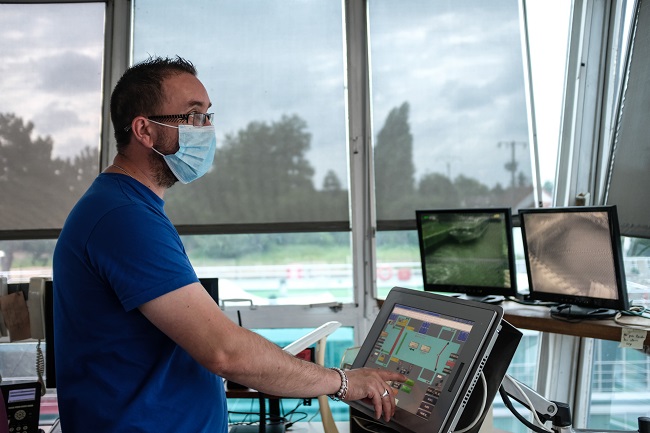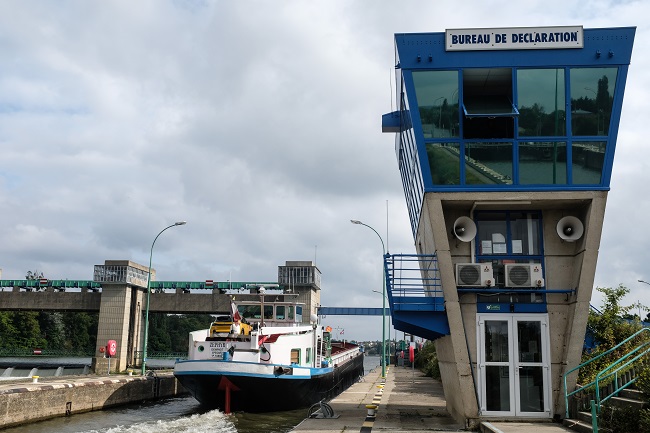A LOCK KEEPER, ALSO KNOWN AS A WATERWAY OR PORT OPERATION OFFICER, IS RESPONSIBLE FOR CO-ORDINATING BOAT TRAFFIC ON WATERWAYS. INTERVIEW WITH MICKAEL DEROUBAIX, LOCK KEEPER AT THE ANDRÉSY WEIR IN THE YVELINES.

It is Monday 30 August, at 10 in the morning. Boats are moving up and downstream of the Seine. We are at kilometre marker 72.5, at the foot of the Andrésy lock-weir. It is a monumental structure that was built in 1957 to replace the needle weir that contributed to developing merchant shipping from 1846, invented by an engineer named Poirée. It was a time when wine barrels, cut stone and gypsum were headed for Paris, Normandy, and beyond.
Here, slightly downstream of the confluence of the Seine and the Oise located on the outskirts of Conflans-Sainte-Honorine, capital of inland water shipping, two locks have since been associated with the structure: one for large boats (185 metres long and 24 metres wide) and another for smaller boats (160 metres long and 12 metres wide). A wide variety of boats can be seen on the water here, from a heavy convoy that can include the equivalent of 200 lorries to a traditional motorised barge via the waltz of tourism cruise boats and other amateur sailing boats. The number of boats coming through per day varies between 50 and 80.
“THERE’S MORE TO MY JOB THAN JUST LETTING BOATS THROUGH”
Mickael Deroubaix is on duty this morning, tucked away in his control tower keeping an eye on the slightest detail. He is the lock keeper responsible for co-ordinating river traffic among other things, and one of a team of seven operation officers. He has been keenly interested in the profession for twelve years since he had a first informative experience at L’Isle-Adam.
The former baker from a family of bargemen tells us, “There’s more to my job than just letting boats through. We play a huge role. We manage the weir by maintaining the river’s level according to how fast it’s flowing, so that the level remains constant. We have a dilution to guarantee as we say. Our job also involves maintaining the structures and green spaces, plus preventative maintenance. But also maintaining the fish ladder, an artificial river that was dug out through the île Nancy to recreate the crossing conditions like those of a natural waterway. And lastly, we may also call the river police if needed.”
[ALSO READ >> COMME UN POISSON DANS L'ILL]

Mickael is installed in front of his operations panel with his lock keeper record book to hand. He can be contacted permanently via a VHF radio. Using the various touchscreens before him he controls the comings and goings of the various geolocated boats registered in the day’s schedule completely independently. Without forgetting to let occasional private boats through.
“Each day we fill in a register where we write down the weir’s levels. This lets us see, throughout our shifts, to see if the waterway stays at the right level or not. The weir is automated but sometimes we have to intervene manually. The barge captains let us know they’re coming through 15 minutes before they go through the lock. I tell them if they need to slow down or speed up depending on how many boats are here. They each have a reference number that indicates where they’ve come from, their load and where they are going.”
Then, it is time for the stage called the lift. The boats rise or descend just by using gravity to fill or empty the chamber. The famous principle of communicating vessels our lock keeper knows like the back of his hand.
“15 minutes are needed on average for each boat to come through”, he says. “I increase the elevation upstream or downstream by 4.50 metres high. Yes, you can say it’s like a lift or the same principle as a bath. Sometimes there are times that are more complicated, especially when the river water level rises. You have to be quick to act when these little water rushes happen as we say.”
“SOON WE’LL BE CONTROLLING AND MONITORING REMOTELY”
Although he has not really seen a great difference in activity during the health crisis (editor: apart from fewer boats from transporters with raw materials for worksites on hold), Mickael remains conscious that his sector, which has a major part to play in the green transition, is set to undergo major change. At a time when the structures are gradually being completely automated, his profession of lock keeper is getting ready to change significantly.

Like dozens of other structures in France, works to modernise operation methods apply to the Andrésy lock-weir. The French State is giving Voies Navigables de France the financial support to do so. VNF intends to make infrastructure management easier while improving the quality and reliability of the service provided. This is being done through automating and revising the gates, installing fibre optics along the network, or installing new generation surveillance cameras.
[READ ALSO >> VNF (VOIES NAVIGABLES DE FRANCE) AFFICHE SES AMBITIONS]
“It’s going to bring in changes for us,” Mickael tells us, who shows his apprehension at being transferred to a main telecontrol centre at Chatou by 2030. He continues, “Soon we’ll be controlling and monitoring remotely. We’re going to have to get used to it because it’s going to feel very different. We won't be on site. Everything will be done by screen and radio. We won't have any more contact.”
While waiting for his job to change, Mickael intends to make the most of the years he has left in his control room. He is keeping a keen eye on how the surrounding area is being transformed. The neighbouring Seine Métropole Ouest port authority intended for the building industry is set to open at a later date. It is supported by Haropa Port with the idea of easing congestion of the Gennevilliers site. This new port will be built on 100 hectares at the sand quarry that’s currently in use, on the left bank facing the confluence of the Seine and the Oise, in the towns of Achères, Andrésy and Conflans-Sainte-Honorine. What will it provide? New jobs and fewer lorries on the roads!
By: Florian Dacheux
About the author
Florian is a thirty-something based in the Paris suburbs. He has been navigating the media world since 2005. He learnt the basics of the profession at a regional daily newspaper in Avignon, and has had various experiences as a correspondent in Barcelona, doing radio reportages in Marseille, or various editorial positions in the digital press in Paris. He has been freelance since 2015 as a reporter and editor for magazines and the digital press, writing articles about various lifestyle topics. Florian also leads writing workshops and does photography.